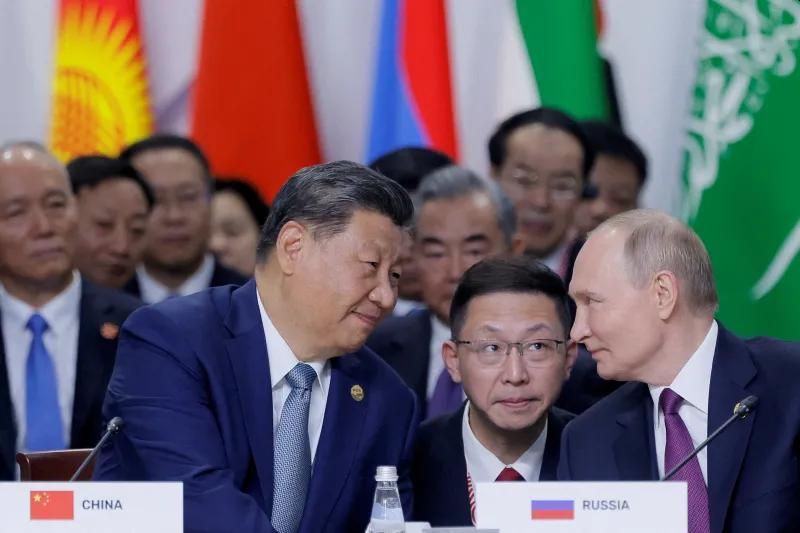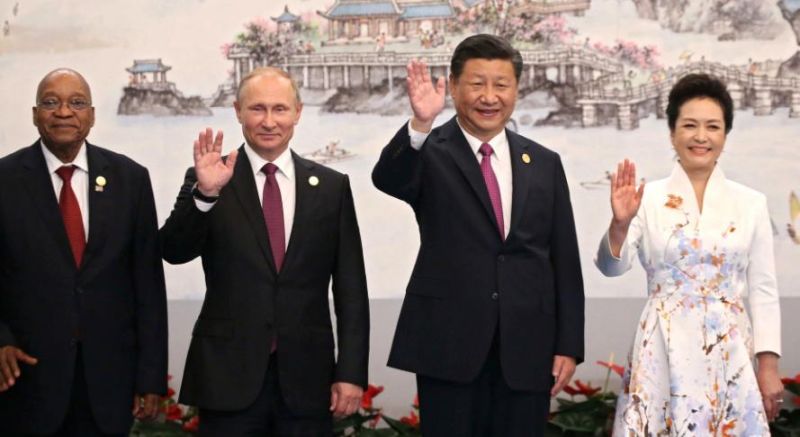By Eric Vandenbroeck and co-workers
Xi Jinping’s
Axis of Losers
The United States is contending with the most challenging
international environment it
has faced since at least the Cold War and perhaps since World War II. One of the
most disconcerting features of this
environment is the burgeoning cooperation among China, Iran,
North Korea, and Russia. Some policymakers
and commentators see in this cooperation the beginnings of a twenty-first-century axis, one
that, like the German-Italian-Japanese axis of the
twentieth century, will plunge the world
into a global war. Others foresee not World War III but a slew
of separate conflicts scattered around the globe. Either
way, the result is a world
at war—the situation is that serious.
What should be done
about this cooperation is another matter. Some strategists argue for ruthless prioritization,
focusing on the members of the
axis that represent the greatest
threats. Others believe that only
a comprehensive effort will
succeed. But the best strategy would
borrow elements of both approaches,
acknowledging that China is the primary
long-term concern for U.S. national security strategy—“the pacing
threat,” in the U.S.
Defense Department’s framing—but
also a different kind of
global actor than its rogue-state partners. Accordingly, Washington’s aim should be to
make clear to Chinese President Xi Jinping how counterproductive and costly to Beijing’s
interests these new relationships will turn out to be. That means effectively countering Iran, North Korea, and Russia in their own regions, thereby demonstrating to China that tethering
itself to a bunch of losers
is hardly a path to global influence.
Brothers in Arms
Cooperation among the members
of this twenty-first-century axis has
been heavily centered on military, industrial, and economic support for Russia in its war on Ukraine,
which could not be sustained without
such help. The resulting defense industrial cooperation and incipient integration is likely to go
well beyond what existed among
the twentieth-century axis partners. North Korea is providing artillery
shells, other munitions, military personnel, and industrial workers to Russia and getting oil and missile and space technology in return. Iran is providing missiles
and drones produced in its defense plants as well helping
to build such plants in
Russia itself, and getting assistance with its own missile, drone, and space programs and perhaps with civil nuclear
power as well. China is so far providing
everything short of actual weapons:
dramatically increased
trade and purchases of oil, gas, and other
natural resources; dual-use technology
that is being
integrated into Russian air-defense, electronic-warfare, drone, and other weapon and communication systems; and as of recently, actual
components for Russian weapons. There is even talk
of producing drone and weapon systems for Russia in Chinese factories. What China is getting in return
is not fully clear at this point, aside
from discounted energy—and potentially unrivaled influence over Russia. Beyond the war in Ukraine, China and Russia and their axis partners
have increased joint training and operations, including with bombers, ships,
and even ground forces.
The axis partners
have also accelerated their diplomatic coordination, with Beijing and
Moscow using their veto power in the United Nations Security Council to protect each another
and Tehran and Pyongyang from adverse resolutions. Reciprocal high-level visits by leaders and top officials have yielded a series of agreements to
cooperate in economic, technological, and other fields.
This twenty-first-century
axis may not be a formal alliance, but it nonetheless represents an increasingly close, highly functional,
and flexible alignment of interests that does not need to
become an alliance to advance its
members’ aims or undermine the
interests of the United States and its allies in Europe, the Middle
East, and Asia. Even without real ideological
affinity, there is a shared anti-Westernism, opposition to democracy, and embrace of authoritarian
alternatives. What truly binds the axis
is not ideology but a common opposition to U.S. power and the
international system it sustains—fueled by a belief that this power represents a mortal threat to
their regimes’ interests, aspirations, and even survival.
The link between China and Russia is especially important.
It is built
on the strong personal relationship
between Xi and Russian President
Vladimir Putin, forged in more
than 60 meetings during their time in office. There are,
of course, both historical and contemporary sources of tension between
China and Russia: a long common
border with lots of empty space
on the Russian side and a
large population on the
Chinese side; Beijing’s suspicion of Moscow’s
revived relationship with North Korea, and Moscow’s suspicion of Beijing’s
growing economic influence in Central Asia; and considerable
xenophobia in both
countries. But these tensions,
although real, are unlikely to be
allowed to disrupt the relationship
between the two governments as long as
Putin and Xi are in charge.
Russian President Vladimir Putin and Chinese President
Xi Jinping at BRICS summit October
2024

The China
Card
Although some commentators have recommended trying to pull the members of
the axis apart, former U.S. Secretary of State Condoleezza Rice leans
in the opposite direction, proposing that policymakers seek to “slam
them together and make them deal with the consequences
of the fact
they don’t actually have all that much in common.”
There is much to be
said for this approach. Any effort to pry
Putin away from the axis will most
certainly fail; he is too dependent on these partners for support in Ukraine. To try to separate North Korea or Iran from the
axis would require concessions that no U.S. administration
is likely to be willing
to make.
But China may be
a different matter. Unlike its
axis partners, China is integrated into
the global economy. The prospect of broad
secondary sanctions—which have been
limited and targeted to
date—if China crosses
Western red lines by providing weapons
to Russia could threaten to exact
real economic costs. Meanwhile, the war on Israel being waged by
Iran and its proxies threatens to disrupt China’s
critical oil supplies and other trade with the Middle East. North Korea’s increasingly bellicose attitude toward its neighbors
has roiled China’s diplomatic and economic relations with South Korea and Japan.
More fundamentally, China has made its
prestige hostage to the success
of its axis
partners. If they should be
seen to be
failing in their respective efforts to impose their
will on their neighbors by force, it
would become clear to the
world that Beijing has cast its lot
with losers. That would not only undermine China’s effort to project itself
as the global leader of a new
kind of international order; it would
also damage Xi’s personal standing, at home and abroad.
How might this goal
be accomplished? With respect to Russia, it means preventing
Putin from achieving his strategic objectives
in Ukraine. This will require enough
sustained Western diplomatic,
economic, and military
support to enable Ukrainian forces to stop the
current Russian advance
and, if not win back occupied territory, at least establish a stable line of contact
between Ukrainian and
Russian forces. Such an outcome
would allow Kyiv to get on with
the job of
building a sovereign, prosperous, noncorrupt, and democratic state increasingly integrated with European economic and security institutions.

Concerning Iran, it means quashing
Tehran’s hegemonic ambitions in the Middle East. In part, this can
be done by
supporting Israel in delivering
strong blows against both Iran and its proxies—Hamas, Hezbollah, the Houthis, and more—to reestablish
deterrence and open the way to a more
stable Middle East. Stability
will allow continued reconciliation between Israel and
its Arab neighbors, the beginning of a more promising future for the Palestinians,
and the chance for the people
of Lebanon to free their
country from domination by Hezbollah.
And concerning North Korea, it means demonstrating
that Pyongyang’s fixation on nuclear weapons and the means to deliver
them will not bring the country security or leverage over
its neighbors. That will require strengthening the diplomatic, economic, and military capabilities of Australia, Japan, South Korea, and other
regional allies and partners
to work with
the United States to deter North Korea and defend against any military
action it might undertake—all with the aim
of continued progress toward a free, open, and peaceful
Indo-Pacific.
Existential
Reconsiderations
Each of these steps
would advance the interests of
the United States and its friends and allies, leaving aside the
message they would send China. But if pursued successfully, they could cause
Beijing to limit and ultimately reduce its commitment to the failing
adventurism of its renegade partners.
There is good reason
to think such a reconsideration is possible, since Xi has adjusted
course under pressure before. Faced with street
demonstrations and other clear expressions of public dissatisfaction,
he abruptly abandoned his zero-COVID policy. In response to the
China strategy forged throughout the Trump and Biden administrations, he changed his approach to
the United States. Early in his
tenure, Xi seemed to have concluded
that the United States and the West more generally
were in terminal decline, presenting an opportunity for China to assert
itself on the global stage; a strong U.S. response backed by a clear
bipartisan consensus, real strategic investment, and a common front with friends and allies prompted Xi to reconsider. The result was a decision to reengage
with the United States, including by meeting
with President Joe Biden in
San Francisco last November, in an attempt to arrest the
decline in U.S.-Chinese relations.
By decisively curbing
the adventurism of his Axis partners,
Washington could cause Xi to change course
once again. It would surely
be in his interest to do so. For if the
recklessness of his partners brings
sustained global instability
and conflict, Xi himself would bear much
of the blame
for preventing the Communist Party from fulfilling its pledges to
make China a “moderately developed economy” by 2035 and a “strong, democratic,
civilized, harmonious, and
modern socialist country” by 2049. The right U.S. strategy could make Xi understand that he can best
serve his interests by breaking
with the axis of losers.
For updates click hompage here